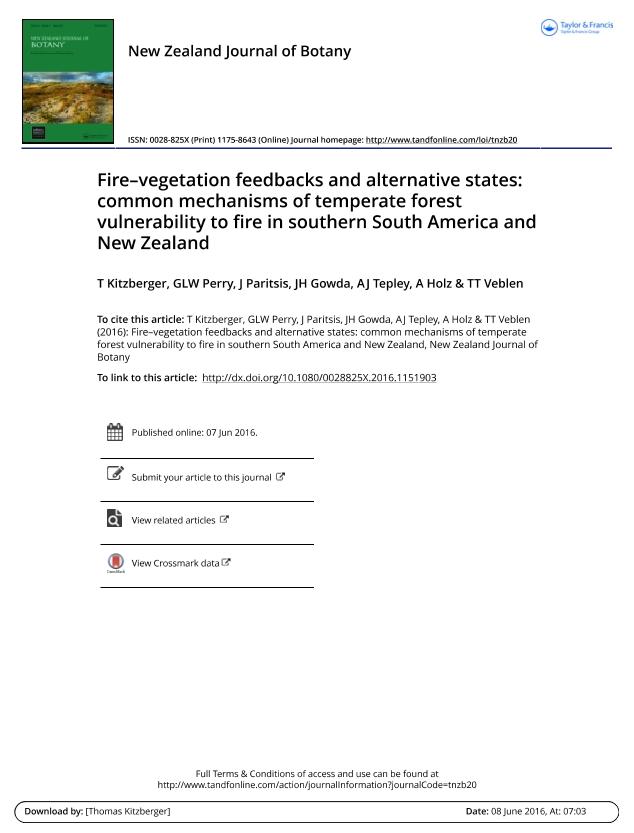Artículo
Fire–vegetation feedbacks and alternative states: common mechanisms of temperate forest vulnerability to fire in southern South America and New Zealand
Kitzberger, Thomas ; Perry, G.L.W.; Paritsis, Juan
; Perry, G.L.W.; Paritsis, Juan ; Gowda, Juan Janakiram Haridas
; Gowda, Juan Janakiram Haridas ; Tepley, A. J.; Holz, Andrés; Veblen, Thomas
; Tepley, A. J.; Holz, Andrés; Veblen, Thomas
 ; Perry, G.L.W.; Paritsis, Juan
; Perry, G.L.W.; Paritsis, Juan ; Gowda, Juan Janakiram Haridas
; Gowda, Juan Janakiram Haridas ; Tepley, A. J.; Holz, Andrés; Veblen, Thomas
; Tepley, A. J.; Holz, Andrés; Veblen, Thomas
Fecha de publicación:
07/04/2016
Editorial:
Royal Society of New Zealand
Revista:
New Zealand Journal of Botany
ISSN:
0028-825X
e-ISSN:
1175-8643
Idioma:
Inglés
Tipo de recurso:
Artículo publicado
Clasificación temática:
Resumen
In the context of global warming and increasing impacts of invasive plants and animals, we examine how positive fire–vegetation feedbacks are increasing the vulnerability of pyrophobic temperate forests to conversion to pyrophytic non-forest vegetation in southern South America and New Zealand. We extensively review the relevant literature to reveal how these temperate southern hemisphere floras have generated similar positive fire–vegetation feedback mechanisms resulting in increased vulnerability to anthropogenically altered fire regimens. For the two regions, we address the following questions. 1. What are the major plant species, physiognomic types and functional types characteristic of pyrophytic versus pyrophobic vegetation types and how do their traits affect flammability, resistance to fire and recovery after fire? 2. What are the roles of herbivory and microclimate in enhancing fire–vegetation feedbacks? 3. Are there similarities in trends of cover type transitions in relation to altered fire regimens? 4. How are climate change, land-use trends and the effects of introduced plants and animals affecting the vulnerability of these ecosystems to fire-induced transitions to alternative stable states? Most temperate forests of New Zealand and southern South America evolved under conditions of low fire frequencies so few taxa became adapted to recurrent fire. Current dichotomous landscapes consisting of juxtaposed pyrophobic and pyrophytic vegetation types are the outcome of the expansion of fire-resilient and fire-promoting species associated with the arrival of humans. Despite considerable differences in human history and biogeographic history, the case studies presented here show remarkable parallels in life-history traits of the key pyrophobic taxa, fire–vegetation feedback mechanisms, overall ecosystem responses to anthropogenic alteration of fire regimens, and likely vulnerability to expected global change influences on future fire regimens.
Archivos asociados
Licencia
Identificadores
Colecciones
Articulos(INIBIOMA)
Articulos de INST. DE INVEST.EN BIODIVERSIDAD Y MEDIOAMBIENTE
Articulos de INST. DE INVEST.EN BIODIVERSIDAD Y MEDIOAMBIENTE
Citación
Kitzberger, Thomas; Perry, G.L.W.; Paritsis, Juan; Gowda, Juan Janakiram Haridas; Tepley, A. J.; et al.; Fire–vegetation feedbacks and alternative states: common mechanisms of temperate forest vulnerability to fire in southern South America and New Zealand; Royal Society of New Zealand; New Zealand Journal of Botany; 54; 2; 7-4-2016; 247-272
Compartir
Altmétricas



